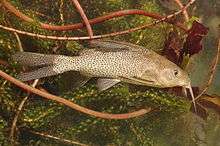Synodontis leopardinus
Synodontis leopardinus, known as the leopard squeaker,[2] is a species of upside-down catfish that is native to the Cunene, Okavango and upper Zambezi Rivers.[3] It was first described by Jacques Pellegrin in 1914. The original specimens were obtained in Barotsés, on the Zambezi River in Zambia.[2] The species name leopardinus means "leopard like", referring to the fish's small black spots on a yellowish body.[4]
| Synodontis leopardinus | |
|---|---|
 | |
| Scientific classification | |
| Kingdom: | Animalia |
| Phylum: | Chordata |
| Class: | Actinopterygii |
| Order: | Siluriformes |
| Family: | Mochokidae |
| Genus: | Synodontis |
| Species: | S. leopardinus |
| Binomial name | |
| Synodontis leopardinus Pellegrin, 1914 | |
Description
Like all members of the genus Synodontis, S. leopardinus has a strong, bony head capsule that extends back as far as the first spine of the dorsal fin.[5] The head contains a distinct narrow, bony, external protrusion called a humeral process.[2] The fish has three pairs of barbels. The maxillary barbels are on located on the upper jaw, and two pairs of mandibular barbels are on the lower jaw.[6] The adipose fin is large and the tail, or caudal fin, is forked.[2]
The front edges of the dorsal fins and the pectoral fins are hardened into stiff spines. These spines can be raised into position at right angles to the body and locked into position for defensive purposes.[7][8] The ability to lock the spines into place comes from several small bones attached to the spine, and once raised, the spines cannot be folded down by exerting pressure on the tip.[8]
The fish has a structure called a premaxillary toothpad, which is located on the very front of the upper jaw of the mouth. This structure contains several rows of short, chisel-shaped teeth. On the lower jaw, or mandible, the teeth are attached to flexible, stalk-like structures and described as "s-shaped" or "hooked".[2][5]
The maximum standard length of the species is 19.6 centimeters (7.7 in).[3] Generally, females in the genus Synodontis tend to be slightly larger than males of the same age.[9]
Habitat and behavior
In the wild, the species occurs in the Upper Zambezi and Okavango River systems.[1] As a whole, species of Synodontis are omnivores, consuming insect larvae, algae, gastropods, bivalves, sponges, crustaceans, and the eggs of other fishes.[10] The reproductive habits of most of the species of Synodontis are not known, beyond some instances of obtaining egg counts from gravid females.[10] Spawning likely occurs during the flooding season between July and October, and pairs swim in unison during spawning.[11] The growth rate is rapid in the first year, then slows down as the fish age.[9]
References
- Marshall, B.E. & Tweddle, D. (2007). "Synodontis leopardinus". IUCN Red List of Threatened Species. 2007: e.T63372A12651337. doi:10.2305/IUCN.UK.2007.RLTS.T63372A12651337.en. Retrieved 15 January 2018.
- "Synodontis leopardinus Pellegrin, 1914". Planet Catfish. 19 Jul 2013. Retrieved 7 November 2016.
- Froese, Rainer and Pauly, Daniel, eds. (2016). "Synodontis leopardinus" in FishBase. June 2016 version.
- Scharpf, Christopher & Kenneth Lazara (12 Sep 2016). "Order SILURIFORMES: Families MALAPTERURIDAE, MOCHOKIDAE, SCHILBEIDAE, AUCHENOGLANIDIDAE, CLAROTEIDAE and LACANTUNIIDAE". The ETYFish Project. Retrieved 7 November 2016.
- Cuvier, Georges (1934). The Animal Kingdom Arranged in Conformity with its Organization, Volume 10. Translated by Griffith, Edward. London: Whittaker and Co. p. 406.
- Boulenger, George Albert (1909). Catalogue of the fresh-water fishes of Africa in the British museum (Natural history). London: British Museum. p. 391.
- Nelson, Joseph; T. Grande & M. Wilson (2016). Fishes of the World (Fifth ed.). John Wiley and Sons. p. 227.
- Scherge, M.; S. Gorb & S. Gorb. Biological Micro- and Nanotribology. Springer Science & Business Media. pp. 97–98.
- H. M. Bishai & Y. B. Abu Gideiri (1965). "Studies on the biology of genus Synodontis at Khartoum". Hydrobiologia. 26 (1–2): 85–97. doi:10.1007/BF00142257.
- Wright, J.J. & L.M. Page (2006). "Taxonomic Revision of Lake Tanganyikan Synodontis (Siluriformes: Mochokidae)". Florida Mus. Nat. Hist. Bull. 46 (4): 99–154.
- John P. Friel & Thomas R. Vigliotta (March 2, 2009). "Mochokidae Jordan 1923: African squeaker and suckermouth catfishes". Tree of Life Web Project. Retrieved 19 October 2016.
External links
![]()
